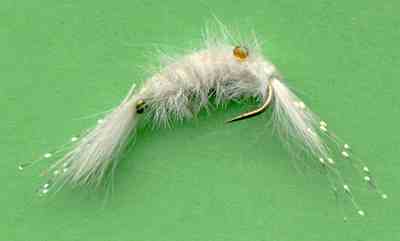The White Scud Fishing Fly
White Scud fly fishing freshwater shrimp pattern takes trout and grayling. Why? It is because one mating pair of scuds can produce upwards of 7 broods, totaling 20,000 offspring per year under ideal conditions. The fish hunt them for food.

SCUD FLY PATTERNS. (also a great freshwater shrimp or louse imitation) Hook size 14 16 18 - $US each
Scudding is the common term used to describe the darting and swift swimming habits of this freshwater shrimp-like creature. From the term scudding they get their name, Scud. Their other name is the Mussel shrimp or Ostracoda. Scuds are members of the class Crustacea, order Amphipoda. Scuds' are distant cousins to the crayfish, sowbugs and shrimp. The beauty of fly fishing with scud imitation flies is that you can use them at any time of the year. They are always available as food for fish even when other insect availability is limited. They are an ideal pattern to use during those non-hatch periods of early spring, late Fall/Autumn and low light conditions of very early morning and late evening. Scientists have identified over 90 different species in the fresh waters of the USA.
There is a greater diversity of scud species in the Midwestern and Eastern states compared with the Western states. They are good general shrimp patterns for catching fish all over the world. Newly hatched young look like smaller versions of the adults. As the young grow they molt their skin (exoskeleton) five to nine times before reaching adulthood. Adults continue to molt another 15 to 20 times during their life as they grow. The time periods between molts can be anything from three days to around 40 days. It depends on the species, availability of food and water temperature. Most species mate and lay eggs anytime between spring and late summer one to fifteen times in the same season. The frequency depends again on the species, availability of food and water temperature. The normal life span of a scud is normally one year but they can live for two years.
A number of anglers use the term 'shrimp' when they mean scuds. If you look closer scuds differ from their distant cousins. Scuds have the appearance an armadillo: hard, segmented exoskeleton with seven pairs of legs carried underneath the body. The front two pairs of legs are used for grasping while the remainder are used for swimming. These legs enable the scud to swim quickly at times, although they commonly move in an erratic and random manner. Some species prefer moving around in an upside down fashion. Scuds also have 2 pairs of antenna. Located between the various pairs of legs are their gills. Scuds spend their entire life beneath the water's surface. There is no pupal stage or emergence of any kind.
One mating pair of scuds can produce upwards of 7 broods, totaling 20,000 offspring per year under ideal conditions. Scuds mate in a piggyback like fashion with the female usually on top. They are omnivorous feeders, eating just about anything. Scuds even attack larger aquatic insects such as damsel fly nymphs and water boatmen in Piranha like fashion, but they seem to prefer a vegetarian diet. Scuds are capable in living in depths as great as 50 ft, but prefer shallower depths of 15 ft or less. Scuds are light sensitive and are most active in low light overcast conditions. These are good days to fish a scud pattern. Scuds take refuge from the light in large numbers under boats and other shady areas like piers.
Scuds come in a wide range of colors. A good rule of thumb is, darker the water the darker the coloration of the scuds. Translucent scuds has a chameleon like quality. During times of low weed growth the scuds will be pale in color. As the weeds grow, scuds are able to change color to match their surroundings. Scuds lose the ability to camouflage themselves effectively as they near the end of their lives. The coloration tends to become various tones of yellow. Scuds with an orange colored spot in the middle of their body, are pregnant females. The orange spot is the brood pouch, or Marsupium. In some Trout stomach samples you will see orange colored scuds. This is not their natural color. When a scud dies the natural coloration disappears, the orange color is due to the presence of Carotene. Carotene transfers to the fish during the digestive process and leads to the beautiful pink flesh.
Fly Fishing books

